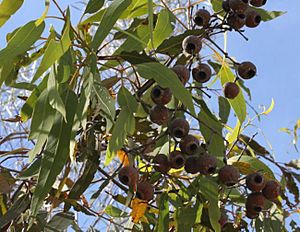Corymbia cliftoniana facts for kids
Quick facts for kids Corymbia cliftoniana |
|
|---|---|
 |
|
| Corymbia cliftoniana growing in Purnululu National Park | |
| Scientific classification | |
| Genus: |
Corymbia
|
| Species: |
cliftoniana
|
| Synonyms | |
|
|
Corymbia cliftoniana is a type of tree that grows only in northern Australia. This means it is endemic to that area. It has thick, rough bark on its trunk and branches that looks like a pattern of small squares. Its adult leaves are long and narrow, shaped like a spear. The tree produces flower buds in groups of seven, which open into creamy white flowers. After flowering, it grows round, woody fruits.
What Does Corymbia cliftoniana Look Like?
Corymbia cliftoniana is a tree that usually grows to be about 8 to 12 meters tall. It has a special woody swelling at its base called a lignotuber. This helps the tree regrow if it gets damaged, for example, by fire.
The bark on its trunk and branches is thick, rough, and flaky, with a pattern that looks like small tiles. Young plants and new shoots growing from the base have heart-shaped or egg-shaped leaves. These leaves later become spear-shaped. They are covered in fine hairs on both sides and are about 40 to 113 millimeters long and 25 to 60 millimeters wide. These young leaves grow in opposite pairs.
Adult leaves are a dull green color on both sides. They are narrow and spear-shaped, measuring about 78 to 150 millimeters long and 10 to 26 millimeters wide. Each leaf tapers down to a stalk called a petiole, which is 10 to 29 millimeters long.
The tree's flower buds grow at the ends of its branches on a thin, branched stalk called a peduncle, which is 8 to 25 millimeters long. Each branch of this stalk holds seven buds. These buds sit on smaller stalks called pedicels, which are 3 to 8 millimeters long.
When the buds are ready to open, they are oval or pear-shaped, about 6 millimeters long and 4 millimeters wide. They have a rounded cap, sometimes with a small point, called an operculum. The tree flowers in January, and its flowers are a beautiful creamy white color. After the flowers, the tree produces a woody, round fruit called a capsule. These fruits are about 15 to 25 millimeters long and wide, and their seed-holding parts are hidden inside the fruit.
How This Tree Got Its Name
This type of eucalyptus tree was first officially described in 1919. It was named Eucalyptus cliftoniana by a botanist named William Vincent Fitzgerald. He wrote about it in a book called A Critical Revision of the Genus Eucalyptus.
Later, in 1995, two other botanists, Kenneth Hill and Lawrence Alexander Sidney Johnson, changed its name to Corymbia cliftoniana. They published this new name in a science journal called Telopea. The second part of its scientific name, cliftoniana, was chosen to honor R.C. Clifton, who was a public servant in Western Australia.
Where Corymbia cliftoniana Lives
Corymbia cliftoniana grows on cliffs and rocky areas made of sandstone and limestone. You can find it from near Derby in the Kimberley region of Western Australia all the way to the Victoria River region in the Northern Territory. It is very common in a famous area called the Bungle Bungle Range.

